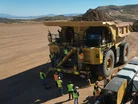Caterpillar: Profile of a Construction Equipment Giant

Caterpillar has warned of a fall-off in sales for Q1 2024 as buoyant demand for machinery shows signs of slowing.
Sales at the company’s construction equipment business fell 5% in the first quarter, while its division that caters to natural resources industries saw a sales decline of 7%, reports Reuters.
Caterpillar reported weak construction equipment sales across all regions except North America, where demand is expected to remain healthy for the rest of the year, thanks to the US government's $1tn Bipartisan Infrastructure Law, to rebuild and modernise the nation's infrastructure across various sectors.
But this failed to offset a slump in demand in Europe and ongoing weakness in China, whose property slump has decimated the construction sector.
"We've been pretty disciplined about making sure that we have cut production like, for example, in excavators ... where we do see softness in the market," Caterpillar CFO Andrew Bonfield said.
Here, we profile Caterpillar and look at its origins, key products and what the future looks like for the company.
Caterpillar: a construction & mining equipment powerhouse
Caterpillar Inc was founded in Illinois, US, nearly a century ago, and has gone on to become a world-famous name in the construction and mining sectors.
It has its roots in the 1925 merger of the Holt Manufacturing Company and CL Best Tractor Co, and has grown into a global powerhouse, producing an extensive range of earthmoving, mining, and power generation equipment.
Its product line-up is a testament to its versatility, but its DNA can be traced back to its iconic yellow bulldozers and excavators that have reshaped landscapes worldwide, as well as to the massive haul trucks and underground mining machinery that extract precious resources from the earth's depths.
The company’s reach today extends beyond construction and mining, with its diesel and natural gas engines, industrial gas turbines, and diesel-electric locomotives powering industries across the globe.
Through a series of strategic acquisitions, Caterpillar has solidified its position in key markets. In 2011, the company acquired Bucyrus International, a leading manufacturer of mining equipment, further bolstering its presence in the extractive industries. The 2010 acquisition of Electro-Motive Diesel, meanwhile, added locomotive manufacturing capabilities to its portfolio.
North America Caterpillar's strongest market
While North America remains Caterpillar's largest market, the company has a significant footprint in the Asia-Pacific region and Europe. Emerging economies such as China, India, and Latin America have also become vital strongholds, as infrastructure development and urbanisation fuel demand for its products.
Recognizing the importance of sustainability, Caterpillar has implemented initiatives to reduce greenhouse gas emissions, improve energy efficiency, and promote the use of alternative and renewable energy sources.
The company's remanufacturing and recycling programs are designed to to extend product lifecycles and minimise environmental impact.
Caterpillar's embrace of cutting-edge technology has been a driving force behind its success. Substantial investments in R&D have seen it lead the way in telematics, automation, and machine learning.
The company is also exploring alternative power sources, such as electrification and hydrogen fuel cells, positioning itself at the forefront of innovation in the industry.
Looking ahead, Caterpillar remains committed to expanding its footprint in emerging markets and capitalising on infrastructure development opportunities worldwide.
- How Caterpillar and Vertiv are Powering Data Centre BuildsBuilt Environment
- The Story Behind Building the US's Biggest Lithium MineTechnology & AI
- Construction Industry Embracing Autonomous EquipmentTechnology & AI
- Electric Construction Machinery Growth 'is Significant'Sustainability & Green Building



